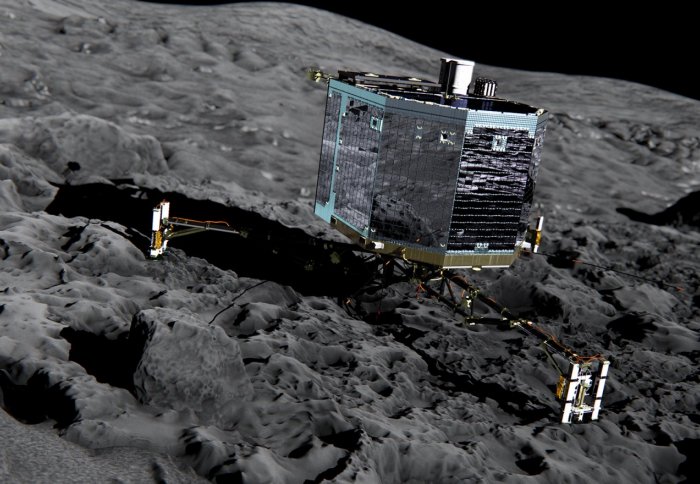Imperial scientists showcase comet-chasing mission at major science exhibition

Rosetta’s lander Philae. Credit: ESA/ATG medialab
The public is being invited to join the chase for a comet at this year's Royal Society Summer Science Exhibition.
The instruments on board Rosetta might seem a bit outdated now, but actually these instruments still have superb performance and they are capable of performing experiments that will unlock the secrets of our solar system
– Chris Carr
Department of Physics
The European Space Agency’s Rosetta spacecraft is scheduled to land on a comet later this year, after a decade-long journey to reach comet 67P/Churyumov-Gerasimenko. The Rosetta mission is trying to help answer questions such as how our solar system formed, how life on Earth began and why there is water on Earth.
In the ‘Catch a comet’ exhibit, visitors will discover what a comet is made of, explore what happens to a comet’s tail as it careers past the Sun, and see a model of Rosetta.
Chris Carr, Senior Research Lecturer in the Department of Physics, has spearheaded Imperial’s involvement in Rosetta since 1996, leading the design and production of a unit that controls the plasma sensors on the spacecraft. In collaboration with the Open University, he and his team of Imperial physicists will showcase the engineering, technology and scientific instruments needed for this one of kind comet chasing mission.
Describing Rosetta’s technology, Chris Carr said: “Rosetta is just finishing a ten year journey to reach comet 67P, but we developed the instruments ten years before it launched, using technology which was state-of-the-art in the 1990’s. The instruments on board Rosetta might seem a bit outdated now, but actually these instruments still have superb performance and they are capable of performing experiments that will unlock the secrets of our solar system.”
Rosetta has travelled so far away from the Sun that its solar panels were not receiving enough energy to keep all its electrical systems going, so it was asleep for 957 days in order to preserve vital energy.
But in January 2014, as Rosetta drifted closer to comet 67P, there was enough energy to awake the spacecraft from its slumber and start to warm up its fuel tanks and navigation instruments. Rosetta is scheduled to catch up with the comet in August and the lander Philae currently onboard Rosetta will make an attempt to land in November later this year.
Imperial physicist Dr Marina Galand who will be on hand at the Royal Society Summer exhibition to explain the science behind Rosetta, highlights Imperial’s involvement in the mission. “There are 11 instruments on board Rosetta, and Imperial is heavily involved in the plasma experiments. Rosetta will follow the comet as it gets closer to the Sun its surface changes from ice to gas. It will be able to witness for the first time the formation of an envelope of gas around the comet. This envelope of gas is called coma, from the Greek, “hair”, referring to the long tail, like long hair which flows in the wind. The gas will be ionised under solar illumination to form a plasma which is made of electrons and ions. We cannot make these observations from Earth, we need to go out into space to probe natural plasma and the Rosetta orbiter offers us the unique opportunity to do it.
The Imperial College podcast caught up with Chris Carr earlier this year, just before Rosetta was reawakened, to find out more about Rosetta and Imperial’s involvement with it.
You can also ask a question about Rosetta in a live Twitter chat on Wednesday 25 June from 12:00-12:45 by tweeting @CatchAComet using the hashtag #asksummerscience.
The Royal Society Summer Science Exhibition ‘Catch a comet’ runs from 1 to 6 July. More stories on Imperial’s other exhibits will follow in the next few days.
Article supporters
Article text (excluding photos or graphics) © Imperial College London.
Photos and graphics subject to third party copyright used with permission or © Imperial College London.
Reporter
Press Office
Communications and Public Affairs
- Email: press.office@imperial.ac.uk
